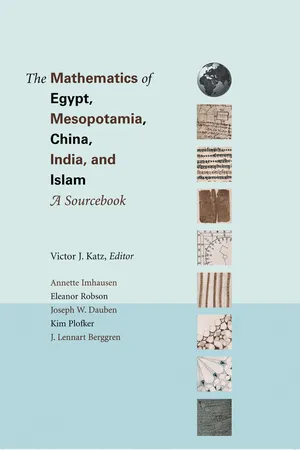
The Mathematics of Egypt, Mesopotamia, China, India, and Islam
A Sourcebook
Victor J. Katz, Victor J. Katz
- 704 Seiten
- English
- PDF
- Über iOS und Android verfügbar
The Mathematics of Egypt, Mesopotamia, China, India, and Islam
A Sourcebook
Victor J. Katz, Victor J. Katz
Über dieses Buch
In recent decades it has become obvious that mathematics has always been a worldwide activity. But this is the first book to provide a substantial collection of English translations of key mathematical texts from the five most important ancient and medieval non-Western mathematical cultures, and to put them into full historical and mathematical context. The Mathematics of Egypt, Mesopotamia, China, India, and Islam gives English readers a firsthand understanding and appreciation of these cultures' important contributions to world mathematics.The five section authors—Annette Imhausen (Egypt), Eleanor Robson (Mesopotamia), Joseph Dauben (China), Kim Plofker (India), and J. Lennart Berggren (Islam)—are experts in their fields. Each author has selected key texts and in many cases provided new translations. The authors have also written substantial section introductions that give an overview of each mathematical culture and explanatory notes that put each selection into context. This authoritative commentary allows readers to understand the sometimes unfamiliar mathematics of these civilizations and the purpose and significance of each text.Addressing a critical gap in the mathematics literature in English, this book is an essential resource for anyone with at least an undergraduate degree in mathematics who wants to learn about non-Western mathematical developments and how they helped shape and enrich world mathematics. The book is also an indispensable guide for mathematics teachers who want to use non-Western mathematical ideas in the classroom.
Häufig gestellte Fragen
Information
Inhaltsverzeichnis
- Cover Page
- Title Page
- Copyright Page
- Contents
- Preface
- Permissions
- Introduction
- Chapter 1: Egyptian Mathematics
- Chapter 2: Mesopotamian Mathematics
- Chapter 3: Chinese Mathematics
- Chapter 4: Mathematics in India
- Chapter 5: Mathematics in Medieval Islam
- Contributors
- Index